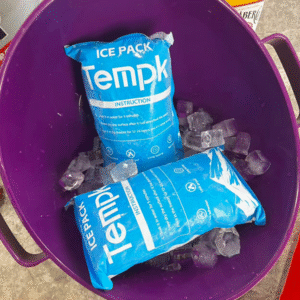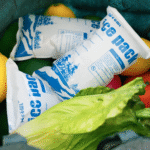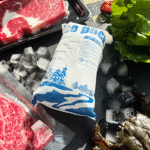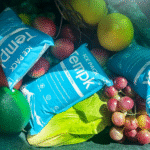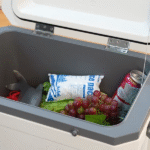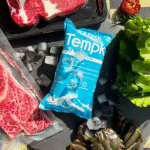How to Use a Lunch Box Dry Ice Pack Safely
UN lunch box dry ice pack can keep meals cold for 4–10 hours when sized and packed correctly. Dans ce guide, you’ll learn how to choose the right pack, prep it, and load your lunch box step by step so food stays fresh and safe without leaks, mess, or frostbite risks.
-
How do you size a lunch box dry ice pack for all-day cooling?
-
What’s the safest way to prep and load a lunch box with dry ice packs?
-
Which materials and lunch bags work best with dry ice packs?
-
How do lunch box dry ice packs compare to gel packs or ice blocks?
-
Que sont les 2025 trends in dry ice pack materials and sustainability?
What is a Lunch Box Dry Ice Pack, et quand faut-il l'utiliser?
Réponse courte: A lunch box dry ice pack is a sealed, reusable cold source engineered to hold sub-zero temperatures and keep food safe for hours. It’s ideal when you need reliable cooling in a compact lunch box—commuting, travail sur le terrain, école, or day trips—without the meltwater of regular ice.
Explication plus longue:
Unlike loose dry ice (solid CO₂ at about −78 °C), a lunch box dry ice pack is a contained PCM (matériau de changement de phase) or CO₂-derived pack designed for everyday food transport. It avoids wet mess, reduces odor risk, and fits routine settings like offices or schools. For most users, one medium pack or two small packs can stabilize the temperature profile of a typical insulated lunch box for 4–8 heures, et jusqu'à 10 heures with better insulation and pre-chilling. If you’re carrying high-risk foods (viande, poisson, laitier), you want a continuous cold chain from fridge to mealtime; a lunch box dry ice pack helps you achieve that.
Is “dry ice” the same as these packs?
Pas exactement. Many consumers say “dry ice pack” to mean “extra-cold pack.” True dry ice is regulated in some contexts and can cause CO₂ buildup in sealed spaces. Packs de glace carbonique pour boîte à lunch mimic sub-zero performance without handling loose dry ice, so they’re safer and simpler for daily use. If you ever use actual dry ice, ventiler, Évitez les phoques hermétiques, et manipuler avec des gants.
How to choose the right lunch box dry ice pack size?
Réponse courte: Match pack mass to food mass and trip length. A practical baseline is 20–30% of the food weight in cold packs for workdays and 30–40% for hotter days or longer routes.
Explication plus longue:
Your lunch box is a small thermal system: food and drink act as a thermal load; the lunch box plus pack provide insulation and cold capacity. To size a lunch box dry ice pack, start with these rules of thumb:
-
Food weight (g) × 0.2–0.3 = pack grams for mild weather and 6–8 hours.
-
Food weight (g) × 0.3–0.4 = pack grams for hot weather or 8–10 hours.
-
If your bag is thinly insulated, ajouter +10% masse de paquet.
-
Si tu pré-refroidir food and bag, you can subtract −10% masse de paquet.
Sizing quick reference (typical insulated lunch box)
| Lunch size | Food load (env.) | Pack size (base de base) | Ce que cela signifie pour vous |
|---|---|---|---|
| Small bento | 400–600 g | 100–180 g | One slim pack keeps fruit/dairy stable for a commute. |
| Standard lunch | 700–900g | 160–270 g | One medium or two slim packs for 6–8 hours at room temp. |
| Hearty lunch | 1.0–1.2 kg | 250–420 g | One large or two medium packs for 8–10 hours; pre-chill helps. |
How do you pack a lunch box dry ice pack for maximum time?
Réponse courte: Préfabriqué, layer smartly, et minimiser l'espace libre.
Steps: Chill food and pack overnight, place the lunch box dry ice pack above and/or alongside denrés périssantes, and insulate any air gaps with napkins or wraps.
Detailed steps:
-
Préfabriqué (best practice).
-
Mettez le lunch box dry ice pack au congélateur 8–12 heures.
-
Pre-chill the lunch box (leave it open in a cool room or place empty bag in the fridge for 30–60 minutes).
-
Commencer par pre-cooled food straight from the refrigerator.
-
-
Use a top-down cold lid.
L'air froid coule. Placez au moins un lunch box dry ice pack en haut. If space allows, add a flat pack at the bottom to create a temperature gradient. -
Create a “cold pocket.”
Arrange the pack so it touches or nearly touches protein or dairy items. Keep fruit and greens cushioned but near the cold mass. -
Remplir l'espace mort.
N'importe lequel air gap warms fast. Use napkins, a small towel, or reusable wraps to fill space around containers. Less air = longer cold time. -
Seal smartly.
Close the bag firmly but do not vacuum-seal. A typical lunch box has enough fabric porosity for normal venting. If using a hard case, avoid over-tight gaskets when using true dry ice. -
Keep out of direct sun.
Shade the lunch box. Radiant heat shortens effective cold time by 20–30%.
Layout that works for most people (standard box)
-
Bas: sandwich or main in a rigid container.
-
Milieu: fruit/veg sides, yogurt or cheese.
-
Haut: lunch box dry ice pack lying flat like a cold lid.
-
Side voids: napkins or wraps to cut air volume.
Is a lunch box dry ice pack safe for kids and workplaces?
Réponse courte: Yes—when you follow basic precautions.
Wrap the lunch box dry ice pack in a sleeve if it feels “too cold to touch,” keep it away from bare skin for long periods, and use food-safe, puncture-resistant packs.
Best practices for safe use:
-
Manutention: If the pack is extremely cold out of the freezer, use a thin cloth wrap.
-
Contact time: Avoid resting the pack directly on bare skin.
-
Conteneurs: Choisir Sans BPA contact surfaces and food-safe films.
-
Ventilation: Pour de la vraie glace carbonique (co₂ solide), never enclose in an airtight container; laisser le gaz s'échapper. Most household “dry ice packs” are sealed coolants, so normal lunch boxes are fine.
-
Étiquetage: Mark the pack “Do not eat.” For kids, choisir soft-edge packs that won’t bruise fruit or fingers.
How does a lunch box dry ice pack compare with gel packs or ice blocks?
Réponse courte: Lunch box dry ice packs deliver longer cold at lower temperatures in compact spaces, while gels are convenient for moderate cooling and regular ice is cheapest but messy.
Comparaison en un coup d'œil
| Option | Bande de température typique | Cold time (same mass) | Mess risk | Utilisation idéale |
|---|---|---|---|---|
| Lunch box dry ice pack | sub-zero to −5 °C band | ★★★★☆ | Très faible | High-risk foods, hot days, long commutes |
| Pack de gel | ~0–5 °C band | ★★★☆☆ | Faible | General lunches, mild weather |
| Ice cubes/blocks | 0 °C band | ★★☆☆☆ | Haut (melt) | Very short trips, budget-only |
Emporter: If food safety or a long day is your priority, le lunch box dry ice pack gagne. For light salads or snacks in spring/fall, gel packs may be sufficient.
Soins, réutilisation, et élimination: make your lunch box dry ice pack last
Réponse courte: Treat your pack like premium cookware. Gentle cleaning, full freeze cycles, and careful storage maximize lifespan.
Routine care checklist:
-
Nettoyer après chaque utilisation. Hand-wipe with mild soap; avoid harsh solvents.
-
Dry before freezing. Moisture can freeze on the exterior and stick to food wraps.
-
Congeler à plat. Flat packs stack better and distribute cold evenly as a “cold lid.”
-
Inspect quarterly. Look for seam wear or swelling. Retire punctured packs.
-
Store at 25–60% freezer load. Overpacked freezers freeze slower; underpacked freezers cycle more and waste energy.
End of life: If the lunch box dry ice pack casing is damaged, follow the manufacturer’s disposal guidance. Many newer packs use non toxique, landfill-safe contenu; some programs accept casings for material recycling.
The 5-minute Lunch Box Dry Ice Pack selector (interactif)
Use this self-check to pick the right setup. Circle your answers, then read your result.
-
Trip length today? UN) ≤4 h B) 5–8 h C) 9–10 h
-
Ambient temp? UN) Indoors 20–23 °C B) Warm 24–29 °C C) Hot 30–35 °C
-
Food type? UN) Snacks/salad B) Dairy/meat C) Sushi/seafood
-
Lunch box insulation? UN) Thick B) Medium C) Thin/fashion tote
-
Freezer pre-chill? UN) Complet 12 h B) 6 h C) No time
If you choose mostly A: One small lunch box dry ice pack (100–150 g) en haut.
Mostly B: One medium pack (160–270 g) en haut; optional slim bottom pack.
Mostly C: One large pack (250–400 g) haut + one medium bottom, combler les lacunes, strict shade.
Advanced tips for power users
Longue queue: insulated lunch bag with dry ice pack
-
Pre-stage food containers in the fridge right against a spare pack for 30 minutes.
-
Mettre protein and dairy closest to the lunch box dry ice pack.
-
Ajouter un doublure réfléchissante or light-color exterior to reduce radiant heat.
Longue queue: reusable lunch cooler dry ice sheets
-
Glace sèche sheet packs fold around containers to increase surface contact.
-
For odd-shaped bento boxes, sheets can outperform a single brick pack of the same mass.
Longue queue: small lunch box dry ice pack for kids
-
Rechercher doux, rounded corners et chew-safe casings.
-
Add a small paper card with handling rules and emergency contact.
Cas réel
Étude de cas: A technician commuted 90 minutes each way in July with a 900 g lunch (yaourt, chicken wrap, baies). Switching from one gel pack to a lunch box dry ice pack (220 g) and pre-chilling the bag extended safe temps from ~5 hours to ~9 hours. The pack was laid flat on top, with napkins filling side gaps for less air volume.
2025 tendances: what’s new in lunch box dry ice pack materials?
Aperçu: Dans 2025, PFAS-free films, recycled PET casings, et CO₂-reclaimed cooling media are becoming mainstream. Manufacturers are optimizing phase-change curves so a lunch box dry ice pack holds colder temps longer without adding bulk. Attendre plus modular sheet formats, dishwasher-safe sleeves, et QR-coded care instructions.
Fast highlights
-
Durabilité: More packs using CO₂ récupéré sources and coquilles recyclables.
-
Optimisation des performances: Narrower PCM transition bands keep food below 5 °C longer.
-
Usability: Mince, flexible sheets that wrap bento containers and stack flat in freezers.
Perspicacité du marché: Consumers value leak-free reliability et compact thickness over raw mass. Brands that publish simple sizing charts et care guides earn repeat use and better reviews.
Questions fréquemment posées
Q1: Can I fly with a lunch box dry ice pack?
Yes—sealed coolant packs are widely accepted. If using vraie glace sèche, respect airline quantity and venting rules. Check your carrier’s policy.
Q2: How long does a lunch box dry ice pack stay cold?
Typiquement 4–8 heures for standard lunches and up to 10 heures with pre-chill, bonne isolation, and minimal sun exposure.
Q3: Is condensation normal?
A little moisture outside the box is normal. Utiliser un soft sleeve or wrap to protect papers/electronics in the same bag.
Q4: Can the pack touch my food container directly?
Yes—contact improves cooling. Avoid direct contact with bare skin for long periods.
Q5: Do I need two packs?
Utiliser deux when the day is long, the weather is hot, or your lunch box is thinly insulated. Place one on top, one at the bottom.
Résumé et recommandations
Points clés: UN lunch box dry ice pack gives longer, colder protection than gels or ice with minimal mess. Size the pack at 20–30% of food mass for most days, 30–40% in heat. Pre-chill overnight, place the pack en haut like a cold lid, et fill air gaps. For kids and offices, choisir soft-edge, à sa sécurité casings and basic handling rules.
Étapes suivantes:
-
Estimate your masse de paquet with the quick formula.
-
Préfabriqué paquet, lunch, and bag.
-
Paquet top-down, fill air gaps, avoid sun.
-
For hot days, add a bottom pack.
-
Track results for a week and fine-tune your routine.
CTA: Want a fast recommendation? Share your food load, température ambiante, et heures—I’ll size a lunch box dry ice pack setup for you.






